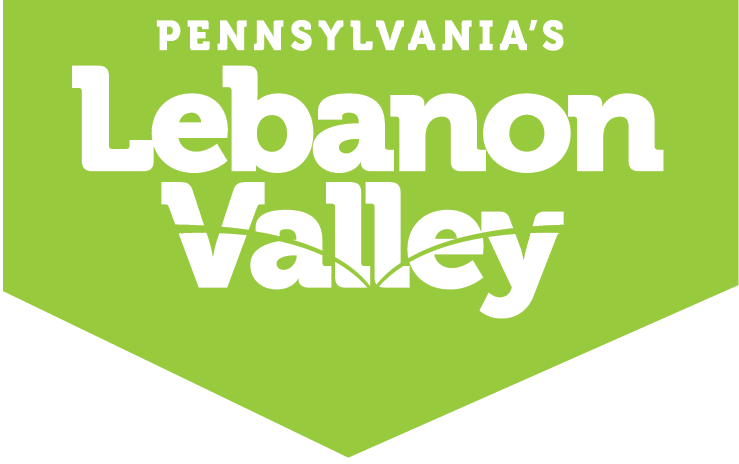The Suzanne H. Arnold Art Gallery at Lebanon Valley College
For the entirety of 2024, Visit Lebanon Valley is celebrating the Year of the Arts by highlighting organizations that bring essential arts and creativity to our community. This month, we are featuring an organization that is a premier destination for the arts in Central Pennsylvania… and it’s right here in the Lebanon Valley!
![]()
Small Town Gallery – Big Time Art
Back in 1994, the Suzanne H. Arnold Art Gallery was opened at Lebanon Valley College in a Gothic Revival style church with a mission to provide museum quality work to the community in and around the college. Today, the art gallery is celebrating its 30th anniversary, continuing its legacy as the intersection of arts and academics for Lebanon Valley College and the Lebanon Valley as a whole.
The Suzanne H. Arnold Art Gallery is run according to museum quality standards, meaning it can host world class art exhibitions from national and regional galleries, collections, and museums. Depending on the exhibition on display, one has a chance of finding works from the likes of the Andy Warhol Museum, the Philadelphia Museum of Art, and other notable institutions, right here in the Lebanon Valley. With its ability to showcase works from famed artists to students just getting started at Lebanon Valley College, the gallery is a truly unique resource for learning and interacting with the arts in the Lebanon Valley.
Transforming multiple times a year with a variety of exhibits, the gallery not only provides an essential arts experience for the local community, but it also provides an innovative learning opportunity for students who participate in gallery internships under the guidance of Dr. Barbara McNulty.

Old Passion – New Perspective
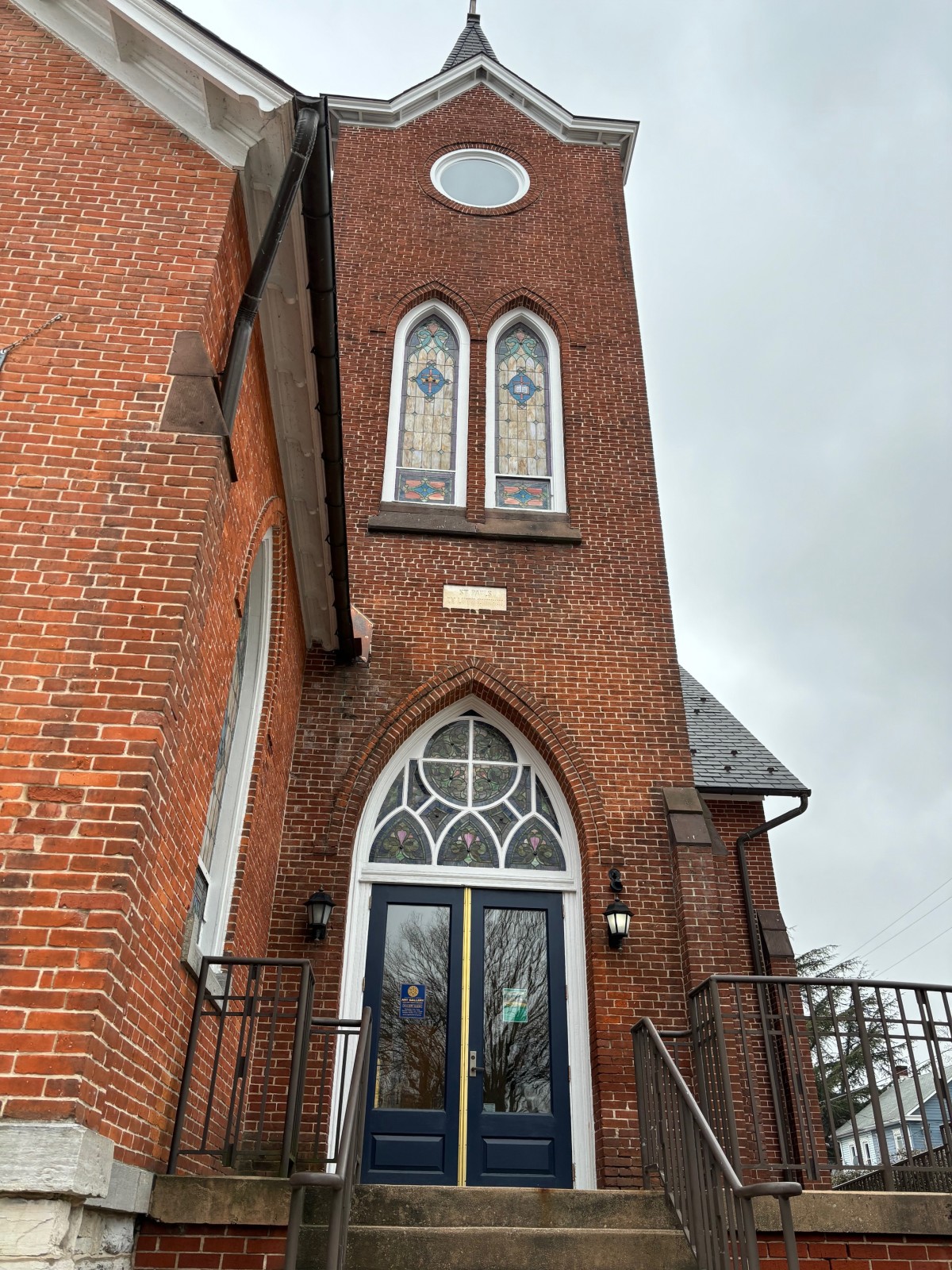
As the Endowed Gallery Director and an assistant professor of art history at Lebanon Valley College, Dr. Barbara McNulty’s work interacts with the arts in a myriad of ways. But a role related to the arts was not always in the cards for Dr. McNulty. Instead, it was a volunteer position in the Art Goes to Schools program that led her to a career in the arts.
“I ran the Art Goes to School program for 13 years in a local school district,” says Dr. McNulty, “I often have students who come up to me now and remember the activities we did, like pretending to be Van Gogh by wearing bandages over our ears or being Michelangelo by crawling under the desks to draw like he did on the ceiling of the Sistine Chapel. It is amazing that they would remember these things.”
Although she had previously found success as a working watercolorist, even presenting her work at the Mount Gretna Outdoor Art Show, this volunteer role sparked a newfound interest in the arts for Dr. McNulty.
“When I became more involved as a volunteer for the school, I found that I loved talking to people about art and teaching art—that became more interesting to me than making it.”
With a new perspective in tow, Dr. McNulty headed back to school, first obtaining her masters in the humanities and later, her doctorate in art history. From there, she found her way to LVC where she feels her experiences in studying art history, working as an artist, and even volunteering and working in roles unrelated to the arts help to guide her work.
“Being the director of a gallery, it’s nice to have all this background,” she says, “I was also in the real estate business where I helped with marketing. Those skills—administration, knowing about art, curating art, and studying art history—have all helped.”
At the Corner of Art & Academia
Dr. McNulty’s role at the gallery and as a professor showcases a valuable intersection between the arts and academics. In her courses, such as museum studies or those on the history of photography, the gallery serves as a valuable learning opportunity for students, “It’s really nice because I usually have a photography exhibition each year, so I can take my photography students on tour in the gallery,” says Dr. McNulty. In her museum studies course, she uses label writing assignments as a way for students to get involved with the preparation and displaying of the gallery exhibits.
In her work with student interns at the gallery and those in her art history courses, Dr. McNulty often shares her story of volunteering and the way that her experiences in a variety of industries and subject matters have come together to bring her to where she is today. Helping her students along in that same journey as they discover what they like to do, and more importantly what they don’t like to do, has been one of Dr. McNulty’s favorite parts of her job, “Those are the kinds of things that excite me the most, to see how I can help students in their journey and interests.”
During my visit to the gallery, Dr. McNulty introduced me to a few of her student workers, one of whom, Sophia, showed us stickers she had made to help spread the word about the gallery among students. Ideas like this are something Dr. McNulty values in working with students at the college, “It’s very autonomous… I hope that they’re comfortable enough to give their ideas—you know they certainly have more perspective on certain things than I do.”
As we sat for our interview, many hands were at work around us putting the final details on the spring exhibit set to open in just a few days. With the art gallery’s assistant on a ladder placing the exhibit title on the wall and students working together to level paintings and organize labels, it was clear that preparing an exhibit like this one was quite the task.

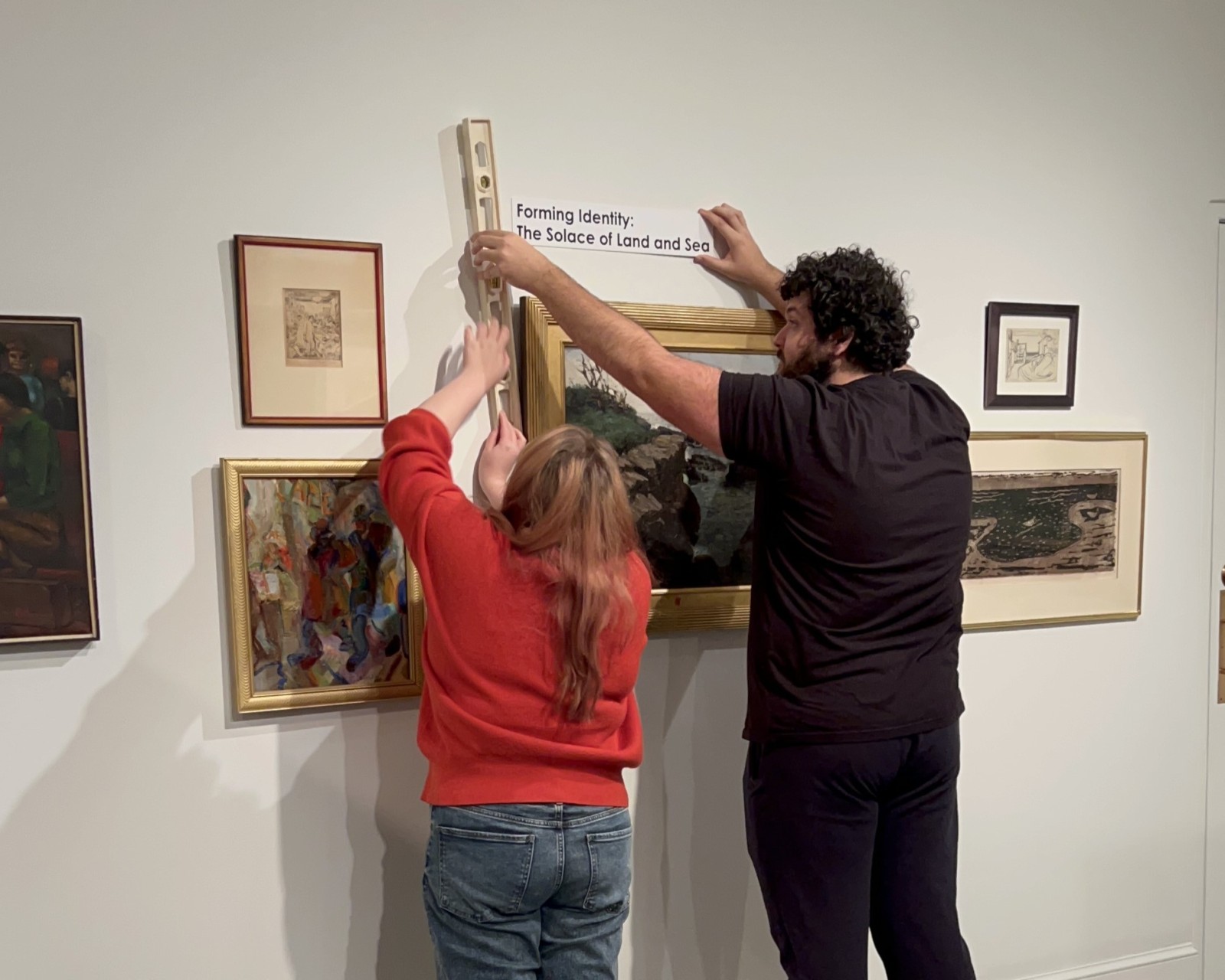
At the Corner of Art & Academia

During my visit to the gallery, Dr. McNulty introduced me to a few of her student workers, one of whom, Sophia, showed us stickers she had made to help spread the word about the gallery among students. Ideas like this are something Dr. McNulty values in working with students at the college, “It’s very autonomous… I hope that they’re comfortable enough to give their ideas—you know they certainly have more perspective on certain things than I do.”
As we sat for our interview, many hands were at work around us putting the final details on the spring exhibit set to open in just a few days. With the art gallery’s assistant on a ladder placing the exhibit title on the wall and students working together to level paintings and organize labels, it was clear that preparing an exhibit like this one was quite the task.
Dr. McNulty’s role at the gallery and as a professor showcases a valuable intersection between the arts and academics. In her courses, such as museum studies or those on the history of photography, the gallery serves as a valuable learning opportunity for students, “It’s really nice because I usually have a photography exhibition each year, so I can take my photography students on tour in the gallery,” says Dr. McNulty. In her museum studies course, she uses label writing assignments as a way for students to get involved with the preparation and displaying of the gallery exhibits.
In her work with student interns at the gallery and those in her art history courses, Dr. McNulty often shares her story of volunteering and the way that her experiences in a variety of industries and subject matters have come together to bring her to where she is today. Helping her students along in that same journey as they discover what they like to do, and more importantly what they don’t like to do, has been one of Dr. McNulty’s favorite parts of her job, “Those are the kinds of things that excite me the most, to see how I can help students in their journey and interests.”

Many Hands Make Light(er) Work
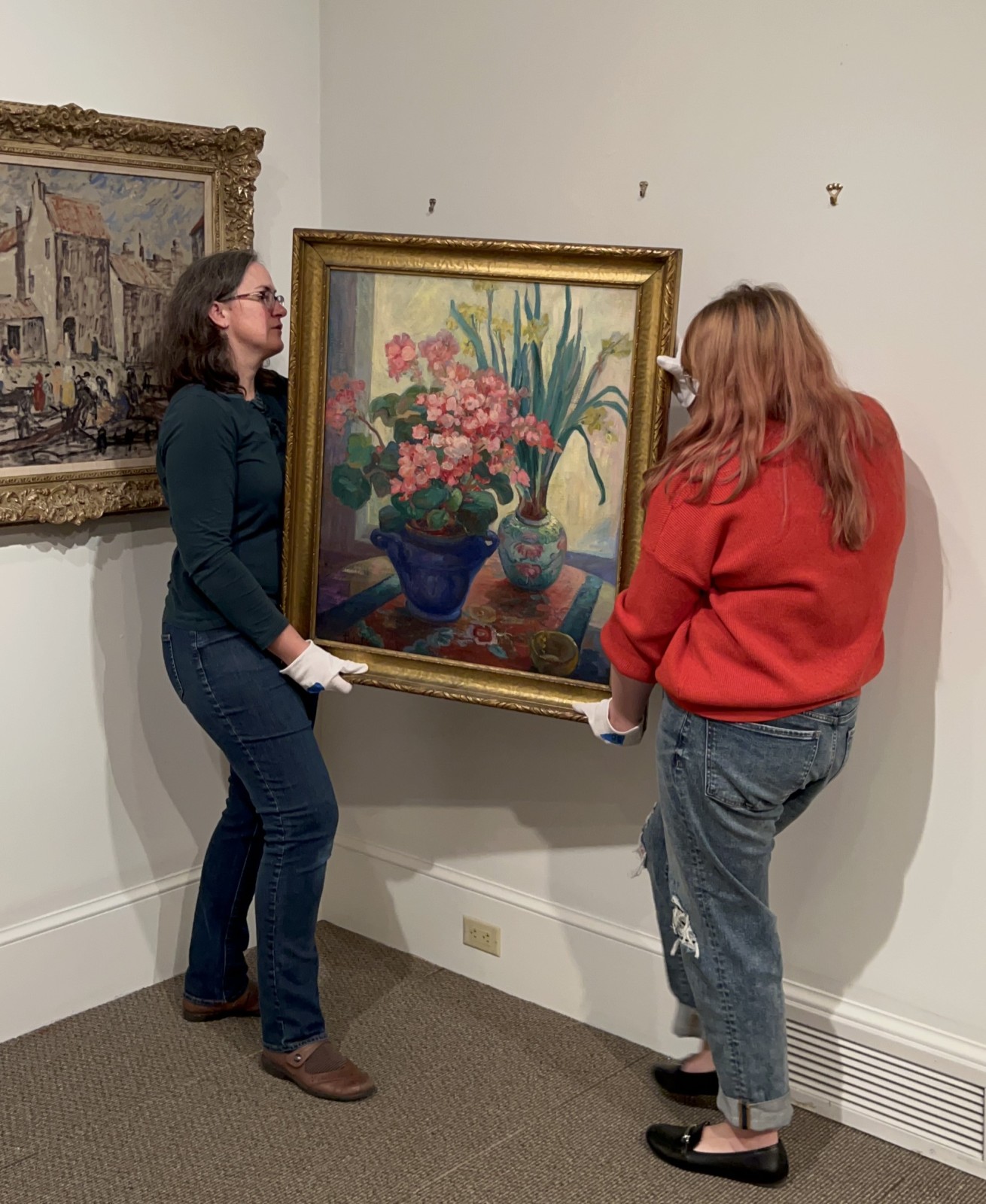
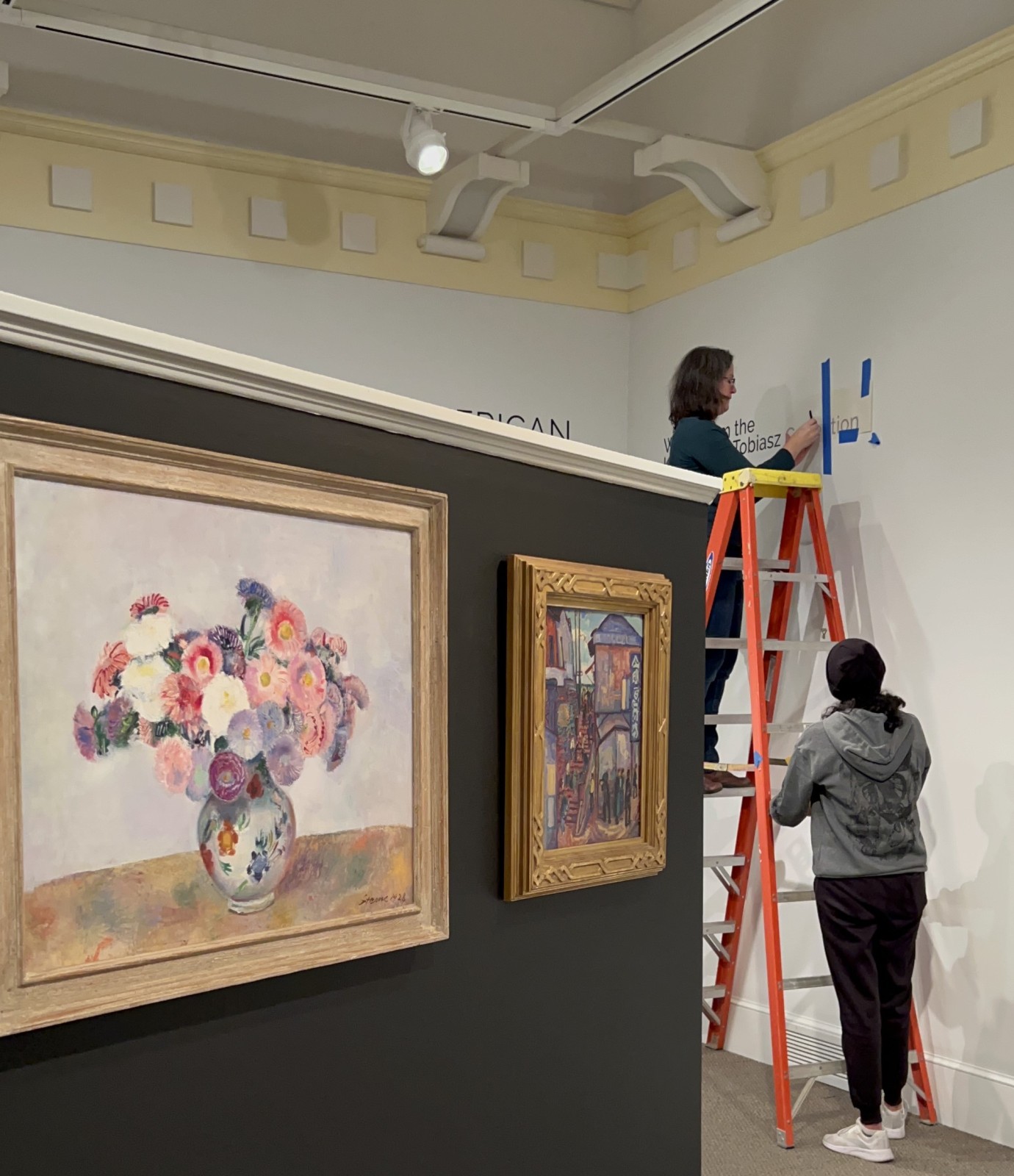
While it’s no secret that art can come with a substantial price tag, the process of bringing art together for an exhibition is also quite substantial. Dr. McNulty and art gallery assistant, Dr. Kristine Larison, each shared some aspects of the process that came with preparing the spring exhibit of “American Modernism: Works from the Kruszewski-Tobiasz Collection.” From our conversations, it quickly became evident that the process was anything but easy.
The first step in preparing this year’s spring exhibit was the decision of what it would cover. Back when she was meeting Dr. Kruszewski for the first time in the spring of 2013, Dr. McNulty remembers hearing of his plans to use the collection to share the ways that art impacts American society for the better. Since that meeting, the gallery has done three collaborations with the Kruszewski-Tobiasz collection, and after visiting Dr. Kruszewski’s collection to discuss some of his favorite works and the themes that both parties were interested in, the final checklist was concluded for this fourth collaboration.
After choosing the works for the exhibit, there was then the cost and effort of transporting the works to the gallery. As shared by Dr. McNulty, transportation can often cost thousands of dollars in addition to what is spent to get the exhibit, not to mention the costs associated with insuring the work.
Then, once the art works safely arrived at the art gallery, the work began with setting up the exhibit and laying out the works. Dr. Larison described just a few of the tasks in this process, some of which involved writing labels for the works, measuring and placing the works, and even just educating student workers about the exhibition itself. There is also the exhibit’s catalog, which features an essay written by Dr. Larison on the stories behind the art works. At 144 pages, it speaks volumes to the work that goes into an exhibition like this one.
And while these steps just touch the surface of the preparations involved in the spring exhibition, there’s more to be told when it comes to art itself.
Many Hands Make Light(er) Work

While it’s no secret that art can come with a substantial price tag, the process of bringing art together for an exhibition is also quite substantial. Dr. McNulty and art gallery assistant, Dr. Kristine Larison, each shared some aspects of the process that came with preparing the spring exhibit of “American Modernism: Works from the Kruszewski-Tobiasz Collection.” From our conversations, it quickly became evident that the process was anything but easy.
The first step in preparing this year’s spring exhibit was the decision of what it would cover. Back when she was meeting Dr. Kruszewski for the first time in the spring of 2013, Dr. McNulty remembers hearing of his plans to use the collection to share the ways that art impacts American society for the better. Since that meeting, the gallery has done three collaborations with the Kruszewski-Tobiasz collection, and after visiting Dr. Kruszewski’s collection to discuss some of his favorite works and the themes that both parties were interested in, the final checklist was concluded for this fourth collaboration.

After choosing the works for the exhibit, there was then the cost and effort of transporting the works to the gallery. As shared by Dr. McNulty, transportation can often cost thousands of dollars in addition to what is spent to get the exhibit, not to mention the costs associated with insuring the work.
Then, once the art works safely arrived at the art gallery, the work began with setting up the exhibit and laying out the works. Dr. Larison described just a few of the tasks in this process, some of which involved writing labels for the works, measuring and placing the works, and even just educating student workers about the exhibition itself. There is also the exhibit’s catalog, which features an essay written by Dr. Larison on the stories behind the art works. At 144 pages, it speaks volumes to the work that goes into an exhibition like this one.
And while these steps just touch the surface of the preparations involved in the spring exhibition, there’s more to be told when it comes to art itself.
At the Gallery this Spring
This spring’s exhibition is titled “American Modernism: Works from the Kruszewski-Tobiasz Collection” and features a curated selection of art works from the collection of forensic psychiatrist Dr. Stefan Kruszewski and his partner, David Tobiasz.
The works from their collection that were chosen for the exhibit showcase a glimpse of American Modernism from the end of the 19th century to the beginning of the 20th century. Displayed around the gallery, the works represent a variety of artistic media, including paintings, drawings, prints, photographs, and sculptures; as well as a variety of art movements that occurred within American Modernism, such as American Impressionism and the Ashcan School.
As explained by Dr. Larison in the catalog introduction, “What this exhibition and accompanying catalog seeks to demonstrate is not a faded dichotomy between the American schools of modernism and their European models/exemplars, but rather a complex and evolving situation in which American artists at the turn of the century were pursuing a dynamic exploration of new ways of seeing and depicting the complexities of life around them.”
Within the gallery, the works are carefully laid out in a roughly chronological order according to their themes and the movements that they represent. As shared by Dr. Larison, the works in this collection largely reflect what was going on in America at the time of their creation, “The cities were growing, skyscrapers were being built, subways were being built, there was a huge influx of immigrants, but this economic boom was also informing American identity and prosperity,” she says.
And while it may seem that political, economic, and social events and motions are separate from what an artist creates, Dr. Larison makes it clear, “The arts are a part of that. Artists are not just depicting the city or photographing the city, though we have some examples of that here, but they’re also reacting to the energy and the movement.”
Looking back at how these art works reflect the trends, movements, and situations of their time, it bodes to a similar conversation about the impact of art in our community today.

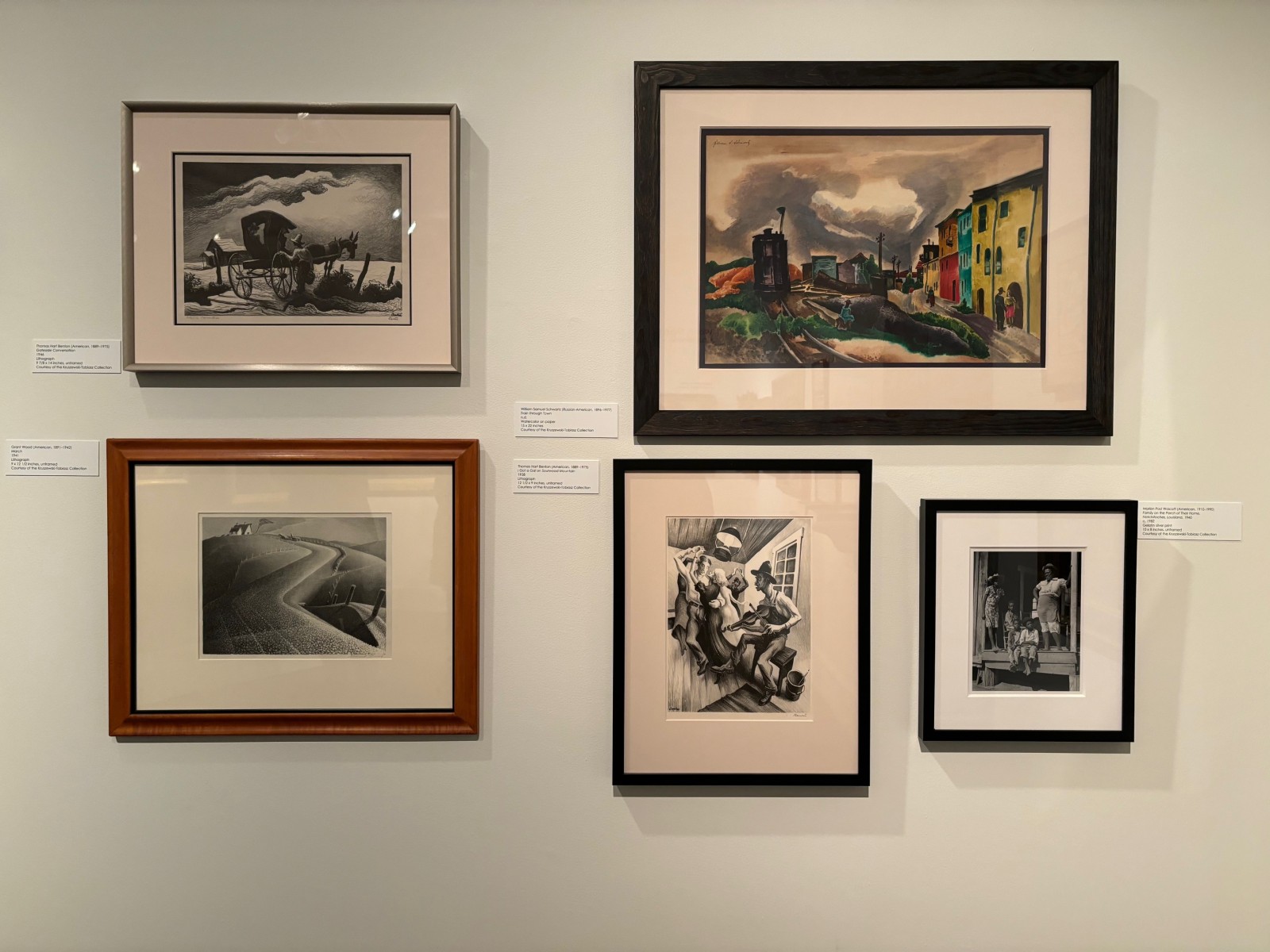
At the Gallery this Spring
Within the gallery, the works are carefully laid out in a roughly chronological order according to their themes and the movements that they represent. As shared by Dr. Larison, the works in this collection largely reflect what was going on in America at the time of their creation, “The cities were growing, skyscrapers were being built, subways were being built, there was a huge influx of immigrants, but this economic boom was also informing American identity and prosperity,” she says.
And while it may seem that political, economic, and social events and motions are separate from what an artist creates, Dr. Larison makes it clear, “The arts are a part of that. Artists are not just depicting the city or photographing the city, though we have some examples of that here, but they’re also reacting to the energy and the movement.”
Looking back at how these art works reflect the trends, movements, and situations of their time, it bodes to a similar conversation about the impact of art in our community today.

This spring’s exhibition is titled “American Modernism: Works from the Kruszewski-Tobiasz Collection” and features a curated selection of art works from the collection of forensic psychiatrist Dr. Stefan Kruszewski and his partner, David Tobiasz.
The works from their collection that were chosen for the exhibit showcase a glimpse of American Modernism from the end of the 19th century to the beginning of the 20th century. Displayed around the gallery, the works represent a variety of artistic media, including paintings, drawings, prints, photographs, and sculptures; as well as a variety of art movements that occurred within American Modernism, such as American Impressionism and the Ashcan School.
As explained by Dr. Larison in the catalog introduction, “What this exhibition and accompanying catalog seeks to demonstrate is not a faded dichotomy between the American schools of modernism and their European models/exemplars, but rather a complex and evolving situation in which American artists at the turn of the century were pursuing a dynamic exploration of new ways of seeing and depicting the complexities of life around them.”

The Mural of the Story
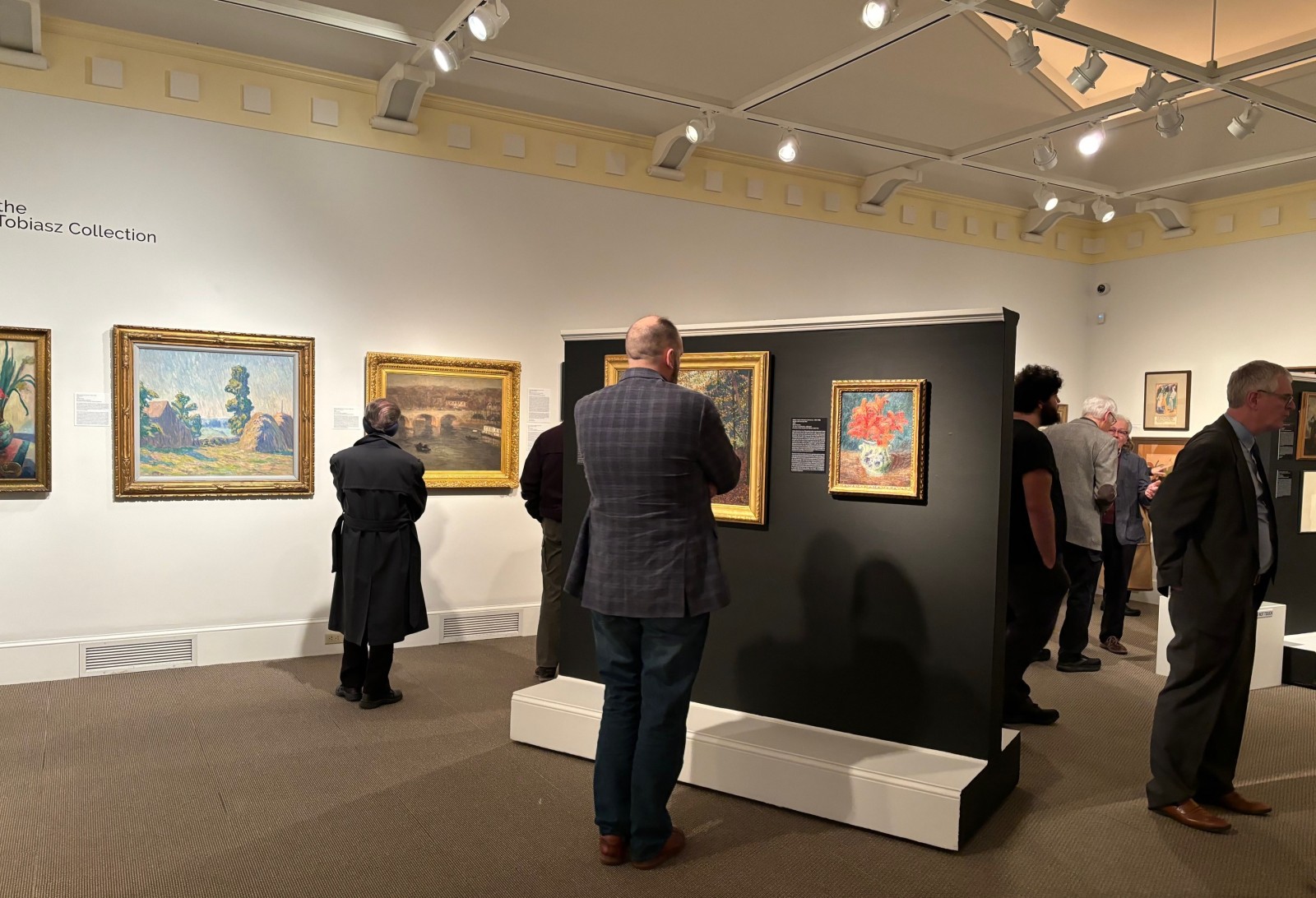
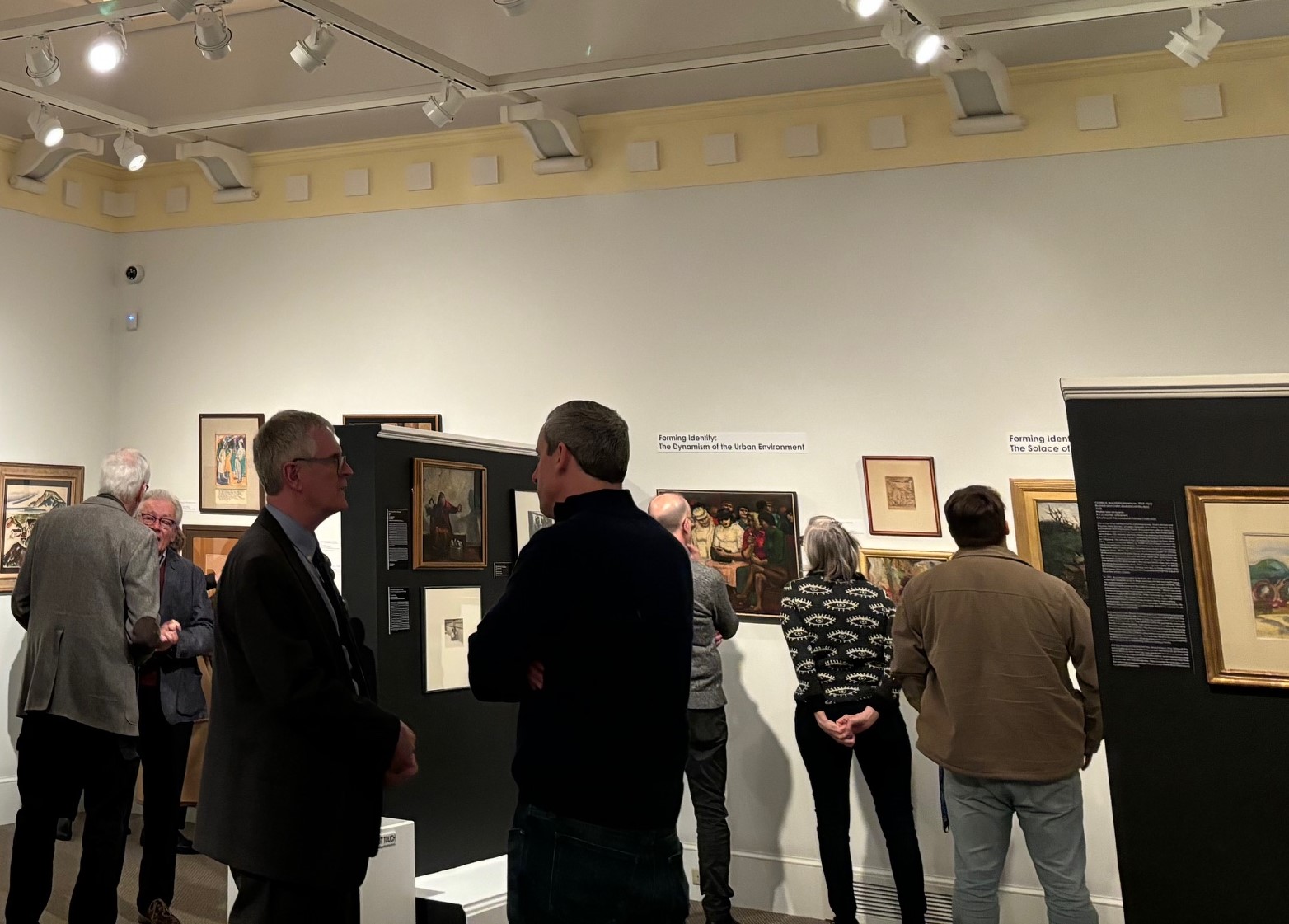
As the only art gallery in the Lebanon Valley operating on museum quality standards, the Suzanne H. Arnold Art Gallery plays an important role in bringing the arts to our community here in the Lebanon Valley. Further, it is through this gallery that students, just like those who helped Dr. McNulty bring this exhibit to fruition, have the chance for an immersive learning experience where they can appreciate world class art and ultimately progress in finding their purpose.
For Dr. Kruszewski, the collector behind the exhibit, a career as a physician was always his goal. After working through his undergraduate studies at Princeton University and matriculating into medical school at Harvard, this dream turned into a reality, as Dr. Kruszewski found a successful career as a forensic psychiatrist.
But throughout his medical studies and the pursuit of becoming a physician, art was always a big part of Dr. Kruszewski’s life. From sketching in first grade to visiting the Princeton Art Museum nearly every day in college to the oil paintings he does now, Dr. Kruszewski writes, “I don’t remember a time in my life without art.”
Dr. Kruszewski’s life within art is a great example of how this seemingly simple subject, “Art,” can have such a profound impact on one’s life and community. As we celebrate the Year of the Arts here in the Lebanon Valley, as well as the 30th anniversary of the Suzanne H. Arnold Art Gallery, we hope to honor all that the arts brings to our community, our people, and our future.
The Mural of the Story

As the only art gallery in the Lebanon Valley operating on museum quality standards, the Suzanne H. Arnold Art Gallery plays an important role in bringing the arts to our community here in the Lebanon Valley. Further, it is through this gallery that students, just like those who helped Dr. McNulty bring this exhibit to fruition, have the chance for an immersive learning experience where they can appreciate world class art and ultimately progress in finding their purpose.
For Dr. Kruszewski, the collector behind the exhibit, a career as a physician was always his goal. After working through his undergraduate studies at Princeton University and matriculating into medical school at Harvard, this dream turned into a reality, as Dr. Kruszewski found a successful career as a forensic psychiatrist.

But throughout his medical studies and the pursuit of becoming a physician, art was always a big part of Dr. Kruszewski’s life. From sketching in first grade to visiting the Princeton Art Museum nearly every day in college to the oil paintings he does now, Dr. Kruszewski writes, “I don’t remember a time in my life without art.”
Dr. Kruszewski’s life within art is a great example of how this seemingly simple subject, “Art,” can have such a profound impact on one’s life and community. As we celebrate the Year of the Arts here in the Lebanon Valley, as well as the 30th anniversary of the Suzanne H. Arnold Art Gallery, we hope to honor all that the arts brings to our community, our people, and our future.
“For me, art transcends time. As much of my life and situation change, my reaction to any work of art is different at any time or day.”
